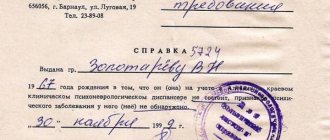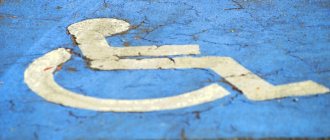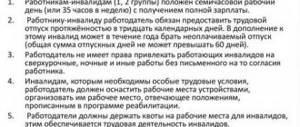According to experts, group 2 can be assigned to those who have mental disabilities, speech problems, sensory disorders (tactility, vision). They do not exclude damage from the circulatory system, physical deformities, etc. (the list is quite large). In any case, a person has the right to register a disability if for one reason or another (injury, illness, etc.) his life activity is limited and he needs social and government support. Next, we will consider the most popular questions regarding group 2 and specific health problems.
When is disability group 2 given for a general illness?
Disability group 2 - established for a period of 1 year. According to the existing procedure, the criterion for establishing disability group 2 is a person’s health impairment with the 3rd degree of severity of persistent impairment of body functions, caused by diseases, consequences of injuries or defects (i.e., persistent severe impairment of the functions of the human body, caused by diseases, consequences of injuries or defects, in the range from 70 to 80%), leading to the II degree of severity of restrictions in one of the following categories of human life (or a combination thereof), which determine the need for his social protection, namely:
- the ability to self-care with regular partial assistance from others, using assistive technology if necessary;
- the ability to move independently with regular partial assistance from others, using assistive technology if necessary.
- Also, a condition for establishing disability group II is the ability to navigate with regular partial assistance from other persons, using auxiliary technical means if necessary.
- ability to communicate with regular partial assistance from others, using assistive technology if necessary;
- constant reduction of criticism of one’s behavior and environment with the possibility of partial correction only with the regular help of other people;
- the ability to learn and receive education within the framework of federal state educational standards in educational and other organizations with the creation of special conditions for receiving education only according to adapted educational programs and adapted (basic) educational programs, if necessary - study at home and / or using distance technologies with the use (if necessary) of special auxiliary technical means, determined taking into account the conclusion of the psychological, medical and pedagogical commission.
- In addition, according to the rules for establishing disability group II, one of the criteria is the ability to perform work in specially created conditions using auxiliary technical means.
What is meant by the described disability group?
This group can be provided to an individual if he has relevant diseases, regardless of whether they are congenital or acquired, if there are developmental pathologies from birth or injuries received, as a result of which a persistent disorder of one or more body functions occurs. Is disability group 2 working in Russia? This group, like any other, according to Order of the Ministry of Labor of the Russian Federation dated December 17, 2015 No. 1024n, is not limited in ability to work. The latter is determined by the degree of disability. There are three degrees of disability, while the inability to perform even basic work activity is included in the 3rd degree of ability to work. Therefore, to the question “Is disability group 2 working or non-working?” we can answer that with 1 and 2 degrees of disability, this group is working. This group can be given to an individual in the following cases:
- the person has difficulty moving, perhaps with outside help;
- the person requires assistance when using public transport;
- the same assistance is necessary for correct orientation in time and space;
- there are difficulties with remembering, reproducing, processing information;
- limited contact with other persons.
The main diseases as a result of which an individual can be recognized as a group 2 disabled person: mental, ophthalmological, speech, tactile, pulmonological, phlebological, gastroenterological, neurological, urological, cardiological, endocrinological, as well as various types of physical deformities.
Thus, when answering the question of whether group 2 disability is working or not, one must proceed from how damaged the health of the individual is, whether he can perform all or part of the required functions independently or with someone else’s help.
Employment of people with disabilities, as a rule, is carried out in specialized homes, for example, for the deaf and mute, although according to the existing state program, quotas for places for people with disabilities have been introduced for all enterprises, however, management, as a rule, is in no hurry to hire people with disabilities.
When is disability group 2 given for an indefinite period?
Recognition of permanent incapacity is possible in the presence of tuberculosis, pulmonary insufficiency, or in the absence of a lung. In the same list, for example, cirrhosis of the liver, ptosis of the eyes, disturbances in the functioning of the heart, malignant tumors, problems with the musculoskeletal system, paralysis, abnormalities of the skull, arthrosis of the hip joint and other serious conditions associated with it (grade 1 or 2) .
A group without specifying the terms of examination can be given if:
— removal of a leg without the possibility of installing a prosthesis;
- diseases that cause increased blood pressure;
- different lengths of limbs or removal of one of them and simultaneous loss of vision and hearing;
- anal defect, when treatment is unsuccessful;
- urinary fistula;
— paresis of the limbs with parallel progressive loss of vision or hearing;
— organ transplantation with subsequent positive dynamics for five years;
- mental disorders that have occurred for more than ten years;
— prosthetics of several joints;
- epilepsy or dementia;
— incurable oncological pathology;
— infectious diseases that affect the activity of the central nervous system;
- brain destruction.
It is noteworthy that group 2 disability with no recommission period is determined by ITU specialists after studying the disease, the person’s current condition, etc. To do this, you need, first of all, to provide an application, a referral to the ITU, certificates and extracts that indicate health problems, a passport, SNILS (sometimes they also ask for a work record and its copy, as well as a reference from the place of work or study).
Be that as it may, the possibility of confirming permanent incapacity officially exists if:
— several years have passed since the recognition of incapacity (applies to children and adults)
— Group 2 was appointed four years ago and the rehabilitation measures carried out during this time did not produce an effect (this also applies to children);
— group 2 disability was assigned to the child six years ago (this is relevant for complex oncological anomalies, leukemia).
It is worth adding that if the disease is incurable, you can get a group for an indefinite period immediately if you have a certificate in hand stating that it is impossible to eliminate the anomaly.
The procedure for recognizing a citizen as a disabled person of group 2
First, you need to collect a package of documents established by law. If a person wishes to obtain the status of a group II disabled person, then he must undergo a medical and social examination, in accordance with Article No. 7 of the Federal Law “On Social Protection of Disabled Persons in the Russian Federation” No. 181-FZ. After which, the relevant commission will determine the needs of the examined person for social protection measures, including rehabilitation, based on an assessment of the limitations in life activity caused by a persistent disorder of health and body functions.
Before going to a medical facility, you need to prepare the necessary documentation, in particular:
- Take a referral for an examination prescribed by your attending physician. The paper must contain information about: — The state of human health; — The state of the compensatory capabilities of his body; — Degree of impairment of body functions. — A list of rehabilitation measures that were carried out previously in order to restore the affected body systems and organs. — A person can receive such a referral from the social protection authorities or the pension authority. To receive a referral, you must have medical documents that indicate the presence of health problems. — It may happen that the pension authority, medical institution and social security authorities did not want to issue this referral to the citizen. In this case, he can independently come to the office that conducts the medical examination. Doctors will examine the applicant and determine whether he or she actually has limitations in his or her life activity.
- Certificate of income of the applicant.
- Passport – original and photocopy.
- Citizen's outpatient card.
- Self-completed application for medical examination. If the applicant is unable to do this himself, then this right is transferred to the legal representative.
- Employment history. Required if the applicant has ever worked.
- If the applicant has undergone training, then it is necessary to have a characteristics filled out by the head of the educational institution.
- For citizens who previously worked, you will need to have a reference from your employer.
- If the cause of lost health was a disorder associated with a work injury or occupational disease, you need to have the appropriate act on hand.
When is disability group 2 given for oncology?
As experts note, cancer takes second place as a provocateur of death. Also, according to them, tumors most often affect the mammary glands, genitourinary system, large intestine, lungs, pancreas and skin. For example, with bowel and bladder cancer, even after a successful operation, people are forced to use a colostomy bag or cystostomy, that is, their quality of life deteriorates and they can rely on the group.
And if lung cancer is detected, which in 80% of cases is diagnosed at a late stage, it will be possible to extend the period of temporary disability from 4 to 6 months during combination therapy, but if the lung or its lobe is removed, it will be referred to MTU. As for pancreatic cancer, which occurs mainly in the elderly, due to the unfavorable prognosis, it is necessary to apply for disability as quickly as possible.
Regardless of the type of oncology, on average, temporary disability lasts 90-120 days (sometimes it is extended to 6 months if the outcome is quite favorable and disability is not given). It is known that group 2 is often assigned if persistent disorders are assigned degree 3, and normal functions are lost by 70-80%. By the way, at this level, children are also assigned a group.
If a referral for MSE is received, the commission members will definitely take into account how well the person underwent the surgery to remove the tumor and whether metastases are present. The severity of the condition and a lot of criteria (ability to work, communicate, etc.) are taken into account. The right to disability of group 2, for example, exists in case of a doubtful prognosis due to the removal of an organ, in severe hypoparathyroidism with hypothyroidism and in respiratory failure, when there is bilateral damage to the recurrent nerve.
If we talk about the indefinite group 2 for oncology, it is prescribed in the case of metastasis and zero effect from treatment, as well as in severe intoxication and a serious condition. The same can be said about inoperable benign formations of the central nervous system, which provoked the inability to move normally, speak, etc.
When is disability group 2 given for stroke?
There is a chance to apply for the group only if it is impossible to fully restore brain function after a stroke. That is, what happened should be reflected in work activity and various functions (vision, hearing, etc.). If the problem is really severe and permanent, then you need to take medical results. research, a passport, an extract from the medical history (here, for example, the methods and results of rehabilitation are prescribed), an application for the implementation of medical examination.
To objectively assess a person’s condition after a stroke, data from clinical urine and blood tests, ECG, and REG are taken into account. Experts also take into account criteria such as:
— the applicant’s dependence on others;
— degree of limited ability to self-service;
— quality of orientation in space;
- ability to move without assistance;
— effectiveness of communication with others and the ability to control behavior.
As soon as group 2 is assigned, you can take advantage of the benefits provided and even work, since this opportunity remains available when the appropriate conditions are created.
When is disability group 2 given for Parkinson's disease?
This disease belongs to chronically severe extrapyramidal syndromes, and the anomaly is prone to development. With this diagnosis, as a rule, the activity of the dopaminergic system of the brain (GM) is severely impaired. To put it simply, the problem is manifested by muscle rigidity, hypokinesia, limb tremors and autonomic failure.
As in the first two cases described above, the appointment of the group is carried out by specialists from the ITU bureau. Experts assess the degree of restrictions affecting the performance of everyday tasks, taking into account the intensity of the disease and the presence of accompanying pathologies. For this purpose, for example, the Hoehn-Yahr scale is used, consisting of one intermediate and five main stages.
When the ability to carry out daily activities declines, the Schwab-England scale is used, divided into 11 levels (for example, at 70%, work speed decreases three to four times, and at 10%, self-care is considered impossible). At the same time, group 2 can be obtained if Parkinson’s disease has reached stage 3 or 4 without maintaining the chance of working (or only under special conditions). Often, the patient requires aids (walkers, etc.) to move around.
When is disability group 2 given for spinal diseases?
With osteochondrosis, as experts note, the following indicators are important:
- neck pain (cervicalgia) that does not go away for one to three weeks;
— humeroscapular periarthritis, which has been bothering you for more than four months;
- pain in the acromiloclavicular joint and shoulder, present for six months;
- dizziness in combination with posterior sympathetic syndrome, which does not subside for 3-7 days;
- approximately ten-day radicular syndrome.
The second group is given against the background of a long course of the disease and frequent exacerbations. The same should be said about an operation for which a person requires long-term rehabilitation. It also plays a role whether the patient moves with assistance or not. In some cases, the group in question is prescribed for spondylolisthesis, that is, displacement of the vertebrae. It is important to understand that in addition to the designated universal criteria, there are individual ones that are also taken into account.
And if osteochondrosis has affected the lumbar spine, group 2 is assigned for a year when the pain in the affected area is severe and persistent. In addition, mobility and daily activities should be severely limited. Often a person’s ability to work is in question, since osteochondrosis of the lumbar region is unfavorable.
In case of ankylosing spondylitis, which actively progresses and often worsens, group 2 is assigned as a result of limited functions of the joints and spine of 2-3 degrees, we are also talking about damage to internal organs (heart, kidney, respiratory failure) and the likely performance of work at home (manual work).
In case of a spinal fracture, to assign disability group 2, it is important to have severe pain, obvious impairment of mobility, and numbness of the skin. At the same time, muscle strength reaches 2-3 points, and the tone in one area or another is characterized by spastic elevation. To this should be added bright pathological reflexes. Instrumental examination often indicates unreduced dislocations, ununited fractures, narrowed spinal canals, and irreparable ones. It is obvious that the patient’s ability to work is sharply limited, and movement is difficult.
As for a spinal tumor, significant restrictions, obvious pain, and noticeable neurological symptoms are also required. The tumor, as a rule, cannot be removed, and the prognosis is unfavorable. Only light and minimal work is allowed to be performed.
With a vertebral hernia, pain plays a role, as well as problems with the performance of internal organs and legs and arms. It is noteworthy that violations are necessarily included in the “insurmountable” category. And an intervertebral hernia allows you to get the 2nd group of disability, when exacerbations of the condition last a long time and overtake often, plus, mobility in the spine is limited, jumps in reflexes (either a decrease or an increase), skin numbness, etc. cannot be ruled out.
For scoliosis, the group is given against the background of constant respiratory failure, repeated and persistent exacerbations, and pain that bothers you outside the acute period. In addition, specialists diagnose a lot of neurological disorders. As a result, for example, people may be allowed to work, but only at home.
Finally, only in case of progression of rheumatoid arthritis can one qualify for the group. Plus, it is necessary to have frequent pain, exacerbations that occur up to three times a year. The degree of limitation of joint functions should be equal to three. The spine requires maximum unloading, since its mobility is limited.
The MSE procedure in the process of assigning group 2 occurs as standard, but here the decision is made by a therapist, vertebrologist, traumatologist, neurologist or other specialists related to a specific anomaly. In addition to examining the patient, for example, doctors look at the results of CT, MRI, and X-rays.
Permanent disability for problems with the spine is assigned if:
- the patient is 55 (for a woman) or 60 years old (for a man);
— there have already been 2 (or 1) groups for five years and rehabilitation has been carried out every year.
Payments to disabled people of group 2 in 2019
EDV for disabled people of group 2 in 2021
Monthly payments (MPV) for disabled people of the 2nd group are guaranteed by Federal Law No. 181 “On the social protection of disabled people in the Russian Federation”. Such payments are made at the expense of the Russian Pension Fund. Therefore, in order to apply for EDV, a disabled person needs to contact the local Pension Fund office with a package of relevant documents.
On April 1, 2016, a new monthly allowance was established for disabled people of group 2, it was 2,240 rubles 74 kopecks, and from February 1, 2021 - 2,590.98 rubles . However, the payment is indexed every year.
Social pension for disabled people of group 2 in 2021
In addition to the EDV, citizens are entitled to a social pension for disability, which is one of the types of state pension provision. The social pension for disability group 2 for 2019 is 5,180.24 rubles per month. For people with disabilities from childhood, group 2, 10,360.52 rubles per month . Payments are indexed annually.
When is a group 2 visual disability given?
In the case of uncorrectable visual impairment, when it is difficult for a person to carry out everyday tasks (cooking, going to the toilet, leaving the house, etc.), we can talk about a disability group. In addition, a potential disabled person must need rehabilitation, social protection and third-party assistance. Specifically, group 2 corresponds to third degree low vision and is assigned under the following criteria:
— visual acuity within 0.05-0.1 diopters;
- narrowing the field of view to 10-20 degrees from the point of fixation of the gaze.
Work in this category is permitted under special conditions when vision problems do not affect work.
We also note that the group becomes permanent if the visual ability is lost completely and irreversibly. The same, by the way, applies to persons whose visual acuity in the healthiest eye is no more than 0.03 diopters (without the possibility of rehabilitation). But if there is a possibility of vision improvement, group 2 can be given for a year (after this period, it is necessary to undergo a second re-examination, based on the results of which the group will be extended or removed).
Disability in the Union State
We dealt with the situation of group 2 disabled people in Russia above. What is the situation with disability group 2 in Belarus - is this group working or not in this state? According to the Law of the Republic of Belarus “On Social Protection of Disabled Persons in the Republic of Belarus”, disabled people of any group can work. Work should be determined by the state of their health, and only based on the conclusion of the Ministry of Economic and Economic Commission of the Russian Federation, disabled people may not be allowed to work. The rehabilitation period for disabled people is not defined, and during this period an individual cannot be dismissed from work.
Working group 2 disability in the Republic of Belarus, as in Russia, has a validity period of 1 year, after which the individual must undergo re-examination again. In Belarus, group 2 can be established not only due to disabilities, but also in case of a questionable labor prognosis and contraindications to work. In Russia, to establish a citizen’s disability, a combination of at least two of three conditions is necessary: damage to health with a disorder of body functions due to various diseases, injuries or defects; limiting life activity, including work activity; the need for social protection measures, including rehabilitation and habilitation.
The latter concept was introduced on January 1, 2016 with the enactment of the law “On the habilitation of persons with disabilities.” Habilitation means the primary formation of skills for something and is applied mainly to young children, in contrast to rehabilitation, which is understood as the secondary acquisition of an ability to do something that was previously lost as a result of various diseases, injuries, etc. Consequently, to the question “Is group 2 disability working?” one can answer that in the Union State the group described can be both workers and non-workers.











